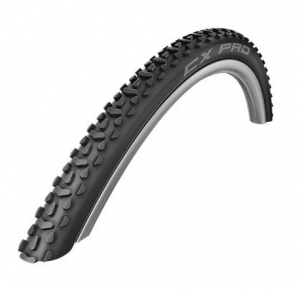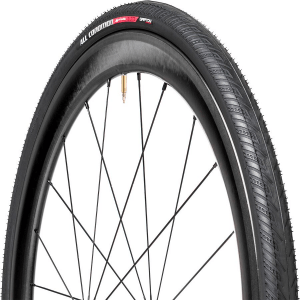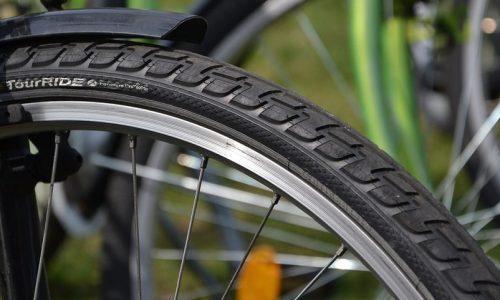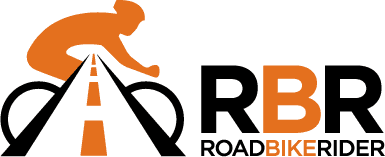With so much reliance your tires being high quality, durable and comfortable, how do you know which are the best hybrid bike tires for you? If you own a hybrid, you probably use it to commute or to get around your local area, which may include puncture inducing gravel tracks or paths.
Even on your daily commute in the city, you will have to avoid broken glass and debris that hides in the gutter.
Without the added protection given by the best tires, you will end up spending more time and money on inner tubes, than if you just bought an annual season ticket for the train.
The Top 5 Hybrid Bike Tires
- Best to prevent punctures: SCHWALBE Marathon Plus HS Wire Tire
- Best for Speed: Continental Grand Prix 4 Season Road Bike Tire
- Best on a budget: Vittoria Zaffiro Rigid
- Best for gripping to the road: SCHWALBE cx Pro Tire
- Best all-rounder: SPECIALIZED – All Condition Armadillo Elite Tire
1. SCHWALBE Marathon Plus HS Wire Tire
Best to prevent punctures
Feeling stable on the road and maintaining a fair amount of grip is essential for your hybrid tires. However, saving you from having to change an inner tube while it is raining on your way to work is an important purchasing factor.
These classics from Schwalbe, have been finely tuned over years of refinement and innovation. Not only do they have durable all-weather tread, meaning you will have the grip you need to stay on the road, even when it is wet. They also have a unique 5mm “Smartguard” belt, which prevents you from getting punctures from the usual debris you find at the side of the road.
Unlike other tires that give you puncture protection that uses Kevlar to reduce the risk of punctures. The Smart guard system is a subsection of supple rubber designed to force sharp objects out, as opposed to drawing them in as deep treaded Kevlar tires can, especially with age.
With this added puncture protection does come a little extra rolling resistance. But if you are using your hybrid to commute or get around the city and prioritize reliability over speed, these tires are an excellent investment.
Pros:
- The best puncture protection system tested
- Reliable
- Surprisingly low rolling resistance for their weight
Cons:
- They are firm, so they can prove challenging to get on and off the wheel
Sizes: 700 x 25mm, 700 x 28mm, 700 x 30mm, 700 x 32mm, 700 x 35mm
67 TPI
2. Continental Grand Prix 4 Season Road Bike Tire
Best for Speed
These tires are advertised as an all-weather road bike tire. The Continental Grand Prix 4 Season, has a lot of the characteristics that you are looking for in a hybrid tire.
It comes with “Vectran Protection” basically Continentals lightweight solution to puncture protection, apparently 5x as light as steel. While that might be questionable, they do withstand the usual rigors of city riding, without puncturing as easily as cheaper tires.
They feel very light on the road and give the least rolling resistance compared to others on this list. Usually lightweight would also mean less grip, however, due to the wear-resistant carbon compound and unique discrete but effective tread, you still feel in control, no matter the weather.
Pros:
- Less rolling resistance
- Puncture protection is good enough for most roads and tracks
Cons:
- Although they do have good traction, you do not have the same confidence as you do with other tires with thicker tread
Sizes: 700 x 23mm, 700 x 25mm, 700 x 28mm
180 TPI
3. Vittoria Zaffiro Rigid
Best on a budget
Vittoria’s low-end series of hybrid tires offers puncture protection and durability (rather than the speed and inevitable skittishness of their race tires). The rigid models feature a 26 TPI casing material. The unique Zaffiro tread pattern—a combination of pebble texture and cross-hatch grooves helps keep you in control in wet conditions.
Unlike its costlier relatives, the Zaffiro series doesn’t suffer from complaints about durability or cost. Riders consistently praise the tire for its long-wearing tread and resistance to flats. These tires are by far the cheapest on the list, and due to the low TPI, you will not be left replacing them every two weeks.
sp;
Pros:
- Cheap
- A decent level of puncture protection
- Durable, with such a low TPI, these tires do not wear out as quickly as lighter tires
Cons:
- They are heavy and give a fair amount of rolling resistance as a result
- Can be challenging to get on and off, because they are so firm
Sizes: 700 x 23mm, 700 x 25mm, 700 x 28mm, 700 x 30mm, 700 x 32mm
26 TPI
4. SCHWALBE cx Pro Tire

Source: amazon.com
Best for gripping to the road, no matter the weather
This tire only comes in one size, but do not let that put you off. The tread is wide and aggressive, built for control while riding off-road and on gravel tracks. However, because they are thin compared to your usual MTB tires, these are great for a hybrid.
Whether you are planning on taking your hybrid bike off the road or want to be in full control in wet conditions on the road, these tires are thin enough not to impact your speed, while offering sufficient grip to give you confidence on corners, no matter the weather.
With the deep tread comes an element of puncture protection as a thorn or piece of glass has to be sizable to get to the inner tube.
These are designed for cyclocross bikes and off-roading, but for that very reason, they are a great addition to any hybrid bike that you want to be able to take on trails as well as the smooth tarmac.
Pros:
- Excellent traction, no matter the weather
- Comfortable to ride on
Cons:
- The thick tread does add weight. So there is more rolling resistance and road friction compared with others on the list
Size: 700 x 30mm
50 TPI
5. SPECIALIZED – All Condition Armadillo Elite Tire – Clincher

Source: competitivecyclist.com
Best all-rounder
This tire from specialized is an excellent addition to any hybrid bike. As the name suggests, the integrated “Armadillo” puncture protection, gives you extra tough puncture protection.
Also, this tire would hold its own on your road bike, due to its compact size and relatively low rolling resistance. The specialized all condition armadillo elite is an all-season tire that has a tire pattern that leaves you in control with incredible traction come rain or shine.
The high TPI means these tires conform to the road and give you a smooth and comfortable ride over terrain. The puncture protection works well against everyday punctures.
Although you should not have to worry about taking the tire off very often, make sure you take quality tire levers with you (the Armadillo puncture protection makes the tire a bit tricky to get on/off your wheel).
Pros
- High puncture resistance
- Enhanced grip in wet conditions thanks to the tread pattern
- Low rolling resistance
Cons
- Due to the dual-compound puncture protection, this tire is heavy, but they have managed to keep weight down by using a high TPI
Sizes: 700 x 23mm, 700 x 25mm, 700 x 28mm, 700 x 30mm, 700 x 32mm
120 TPI
6. Continental Contact plus Tire
The continental Contact plus Tire is an excellent choice for a city bike tire. It is low profile, so won’t be excessively loud or heavy, keeping rotating mass and rolling resistance low.
The Continental EXTRA PunctureBelt technology provides a harder rubber underlayer to the tire, helping to stave off punctures and nicks in the tire, improving the longevity of the tire.
These tires are also 25kph E-bike rated, showing their high durability, especially when used on a hybrid bike instead! The tire is available individually in case of punctures unlike some alternatives.
The Continental brand is a staple of quality within the tire market, and it is worth spending slightly more on a good set of long-lasting tires as they are the bikes only contact with the road.
Sizes: 700 x 28mm, 700 x 32mm, 700 x 37mm, 700 x 40mm, 700 x 42mm, 700 x 47mm
180 TPI
Buyers Guide
When looking at what tire to buy for your hybrid bike, you need to focus on durability, grip and puncture protection. Often puncture protection comes with increased rolling resistance, as the puncture protection is usually heavy, adding to the energy required to keep the wheels spinning (especially at high speed).
Puncture Proof!
No matter what the manufacturers tell you, you will not find a tire that is impossible to puncture. So rather than get too hung up on the puncture protection systems on the tire, make sure you are prepared for the inevitable.
Always carry a small bag, either a saddle/handlebar bag or even a small carrier bag within your backpack that contains everything you need to repair a puncture.
Equipment you will need:
- Spare inner tube
- Tire levels
- Pump or Co2 canisters with fitting
- Puncture repair kit
You should replace the inner tube if you get a puncture. Always make sure you have identified the offending bit of glass, stone or pin that caused the puncture, before inserting your new inner tube.
Puncture repair kits serve their purpose but are not a long term fix. If you have to take the tire off anyway, just put a brand new relatively inexpensive tube in there (rather than patch over the problem only to have to replace the tube next time you take your bike out).
That said, always carry a puncture repair kit, just in case you are having a bad day on the road and end up going through all your spare inner tubes.
What is PSI and is it important?
PSI stands for, pounds per square inch, and it right is essential for optimum riding efficiency and comfort on your hybrid bike. Too little PSI and your hybrid bike will feel sluggish on the roads, too high and your ride will feel bumpy, and you increase the chance of punctures from potholes in the road.
Check what PSI is suggested by the manufacturer, usually printed on the side of your tire.
The classic hybrid tire is similar to road bikes, narrow and designed mainly for road use. Therefore it is recommended to have a psi of 60 – 90.
If you opt for a thicker mountain bike tire, then you will need to drop the psi, but be prepared for a bit of a battle when riding on the road, due to increased road friction.
Always check your tire pressure before and after a ride. No matter how good your tires’ puncture protection is, there will come a stage when you need to replace the inner tube, and it is always best to do it on your terms.
So that you do not have your morning ruined by discovering a flat when you take your hybrid bike out the garage for your morning commute
Top tip: Invest in a stand-up pump with a pressure gauge built-in. Meaning you can keep your tires at the optimum psi for every ride.
What is TPI?
Threads per inch (TPI), refers to the number of threads that cross through one square inch of the tire casing. What does that mean when looking for the best tire for your hybrid? Lower TPI gives better puncture protection, but weighs more and does not provide the same ride quality as a higher TPI.
A tire with a higher TPI conforms with the road, giving a smoother, more comfortable ride, while also being lighter. However, this does make higher TPI tires more susceptible to punctures, cuts and abrasions.
Know your size
Generally, the modern standard for hybrid tires is 700C (or 28 inches). The “700” refers to the rough outer diameter of the tire. The second number represents the width of the tire. For high-performance road bikes, you would be looking at 23mm to 25mm (a reduced surface area so less friction and control).
However, for hybrids, control and comfort are more important than speed alone, so they are generally wider, giving you more grip on the road. Although it is down to your preference, 35mm seems to be perfect width to allow for increased control and comfort (even on gravel tracks), without the tires feeling too sluggish.
Here is a quick conversion chart, as you will find a lot of manufacturers and retailers interchange between metric and imperial measurements.
700×28mm = 28×1.1″
700×30mm = 28×1.2″
700×32mm
700×35mm = 28×1.4″
700×38mm = 28×1.5″
Top tip: Narrower tires are better suited for your hybrid if you mainly ride on the road
Conclusion
Know the terrain you are going to be cycling on and invest in a quality set of tires for your hybrid bike, so you do not have to worry about durability, traction or wasting time at the roadside fixing punctures!
Enjoy the ride!
I’ve spent way more time in the bike trade than anyone should reasonably want to. In that time I’ve wanted to make cycling jargon and marketing easier to cut through to help people get the bike of their dreams.
When I’m not writing about bikes, I can be seen out bikepacking on single speed bikes or teaching kids how to ride.






